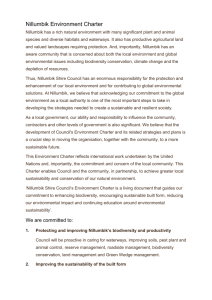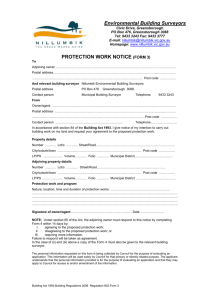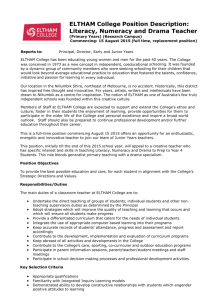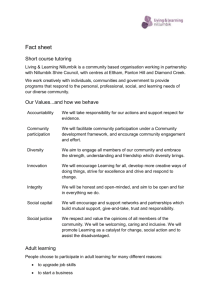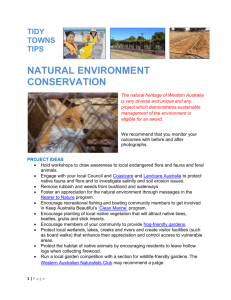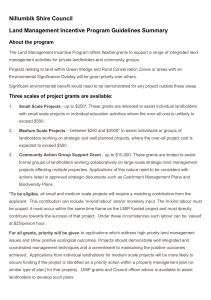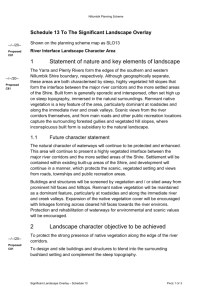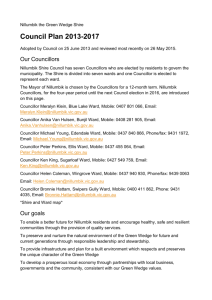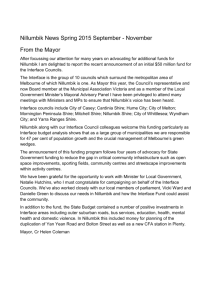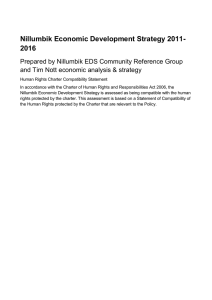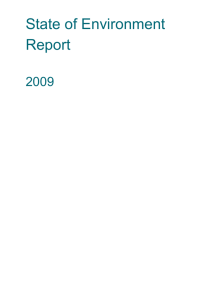Fact Sheet Nillumbik`s Flora and Fauna
advertisement
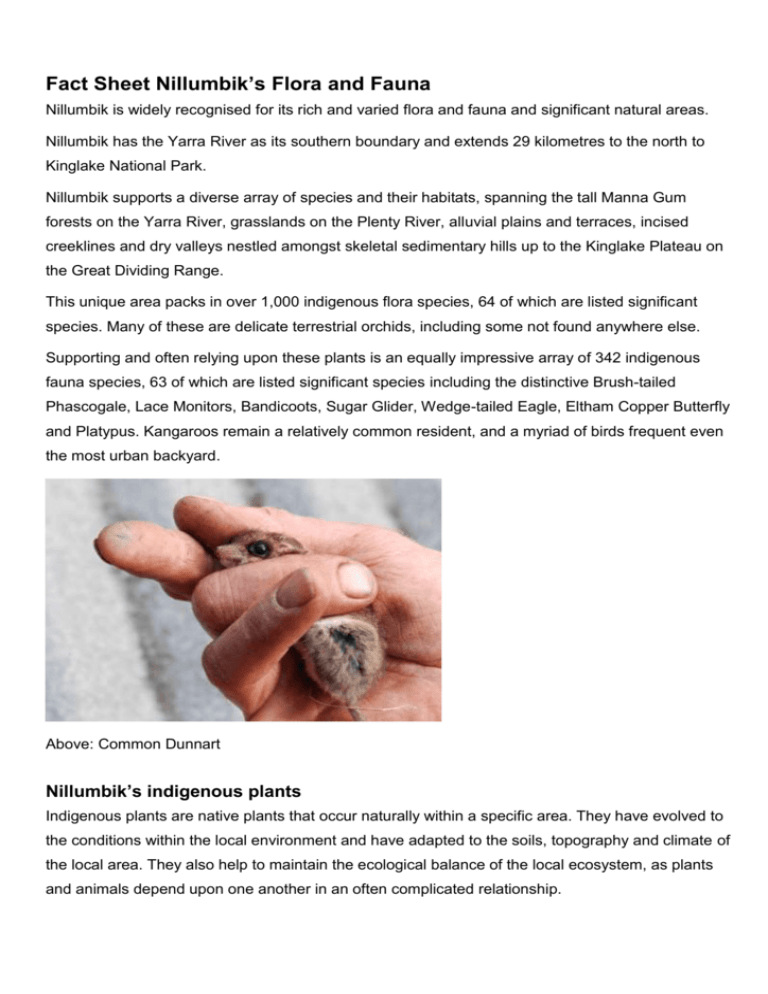
Fact Sheet Nillumbik’s Flora and Fauna Nillumbik is widely recognised for its rich and varied flora and fauna and significant natural areas. Nillumbik has the Yarra River as its southern boundary and extends 29 kilometres to the north to Kinglake National Park. Nillumbik supports a diverse array of species and their habitats, spanning the tall Manna Gum forests on the Yarra River, grasslands on the Plenty River, alluvial plains and terraces, incised creeklines and dry valleys nestled amongst skeletal sedimentary hills up to the Kinglake Plateau on the Great Dividing Range. This unique area packs in over 1,000 indigenous flora species, 64 of which are listed significant species. Many of these are delicate terrestrial orchids, including some not found anywhere else. Supporting and often relying upon these plants is an equally impressive array of 342 indigenous fauna species, 63 of which are listed significant species including the distinctive Brush-tailed Phascogale, Lace Monitors, Bandicoots, Sugar Glider, Wedge-tailed Eagle, Eltham Copper Butterfly and Platypus. Kangaroos remain a relatively common resident, and a myriad of birds frequent even the most urban backyard. Above: Common Dunnart Nillumbik’s indigenous plants Indigenous plants are native plants that occur naturally within a specific area. They have evolved to the conditions within the local environment and have adapted to the soils, topography and climate of the local area. They also help to maintain the ecological balance of the local ecosystem, as plants and animals depend upon one another in an often complicated relationship. In many instances, the loss of particular plants or animals from one area can result in the loss of other organisms in another. For example, the Eltham Copper Butterfly relies on a species of native ant and the indigenous plant Sweet Bursaria (Bursaria spinosa) to complete its life cycle. Due to a decline in the population of this plant, the Eltham Copper Butterfly is now a vulnerable species. Approximately 796 different species of indigenous plants have been recorded in our Shire, ranging from small and delicate ground covers to an assortment of majestic trees, shrubs, beautiful wildflowers, grasses and sedges. Many of these plants are now listed as either rare or threatened under Victoria’s Flora and Fauna Guarantee Act 1988. A number of plants are also listed as endangered or vulnerable under the Federal Environment Protection and Biodiversity Conservation Act 1999. Nillumbik rates consistently above the State average for an area the same in the range and variety of species as listed in Table 1. Table 1 Information for species in Nillumbik compared to statewide averages for an area the same size Plants Nillumbik Statewide average Total species 1211 718 Native/Alien 796/415 538/179 Victorian Rare or Threatened 47 41 Australian Threatened (EPBC) 5 3 Flora and Fauna Guarantee 4 5 Eucalyptus (Myrtaceae) 30 18 Acacia (Mimosaceae) 39 18 Orchid (Orchidaceae) 92 36 Pea (Fabaceae) 72 39 Composite (Asteraceae) 119 86 Plants Nillumbik Statewide average Grass (Poaceae) 162 86 Total Species 329 257 Native/Alien 303/26 244/13 Victorian Rare or Threatened 50 33 Australian Threatened 6 5 Flora and Fauna Guarantee 30 17 Mammal 50 29 Bird 232 200 Reptiles 33 15 Amphibian 14 8 Animals Vegetation Ecological Vegetation Classes 18 Bioregions 3 For a guide to local plants in Nillumbik, please contact Council to receive the free Live local plant local guide, or download it from Council’s website. The main Ecological Vegetation Classes in Nillumbik are Grassy Dry Forest, Valley Grassy Forest, Heathy Dry Forest and Herb-rich Foothill Forest. None of these classes are listed as threatened. However, Box Stringybark woodland is a regionally vulnerable to endangered floristic community of Grassy Dry Forest and is restricted to an area between Yarrambat and Warrandyte in Nillumbik. It is distinguished from Grassy Dry Forest by the high diversity of grasses and herbs, particularly daisies and orchids, and supports a number of threatened species. Small areas of other classes also exist in the Shire including: Box-Ironbark Forest (vulnerable) Gully Woodland (vulnerable) Riparian Forest (least concern) Plains Grassy Woodland (endangered) Creekline Herb-rich Woodland (vulnerable) Swampy Riparian Complex (endangered). Nillumbik’s indigenous animals There are over 300 species of native animals in the Shire of Nillumbik. Nillumbik’s native fauna is protected under state legislation, in particular the Wildlife Act 1975 and the Flora and Fauna Guarantee Act 1988 and under the Commonwealth Environment Protection and Biodiversity Conservation Act 1999. The Department of Sustainability and Environment has identified 84 ‘biosites’ (sites of biodiversity significance) in the Shire. Twelve are of national significance, 33 are of state significance, 38 are of regional significance and one is of local significance (DSE 2007b). There are 14 nationally threatened species, nine migratory species and one threatened ecological community listed as protected under the Environment Protection and Biodiversity Conservation Act 1999. There are also 42 species listed under the Flora and Fauna Guarantee Act 1998 and 120 listed by DSE as rare or threatened in Victoria, all of which have been identified as resident or reliant upon habitats that occur within the Shire at some time. These species include: Powerful Owl (Ninox strenua) Masked Owl (Tyto novaehollandiae novaehollandiae) Swift Parrot (Lathamus discolor) Painted Honeyeater (Grantiella picta) Regent Honeyeater (Anthochaera phrygia) Brush-tailed Phascogale (Phascogale tapoatafa tapoatafa) Common Bent-wing Bat (Miniopterus schreibersii group) Australian Grayling (Prototroctes maraena). Habitat corridors Our native animals are constantly on the move finding food, water, breeding sites and new homes. For example, Brush-tailed Phascogales forage over a large home range: 30-60 hectares for females and 100 hectares for males, nesting in about 30 different sites each year. Habitat corridors are vital to protect animals as they move from one area of bushland to another. These corridors are often lengths of native vegetation along waterways, such as the Diamond Creek and roadsides. Shelterbelts or windbreaks also act as good habitat corridors if they are wide enough. Most of the significant habitat corridors in our Shire are close to or cross over major roads. When driving in Nillumbik you should always be careful of wildlife. If you find an injured, orphaned or sick native animal on the roadside, please contact a local wildlife shelter or call Help for Wildlife on 0417 380 687. Eltham Copper Butterfly The Eltham Copper Butterfly (Paralucia pyrodiscus lucida) was discovered in 1938 in Eltham. After 1956 it was thought to be extinct until a population was found again at Eltham in 1986. Since then, this small butterfly – its wingspan is only 2.5 centimetres – has diminished in abundance and numbers due to destruction of its habitat and the isolation of populations. The Eltham Copper Butterfly is listed as threatened under the Flora and Fauna Guarantee Act 1988 and is considered Vulnerable in Victoria. If you would you like to help an endangered butterfly, then please come along and volunteer for the annual caterpillar surveys of the Eltham Copper Butterfly. Counts begin in October each year. Above: Eltham Copper Butterfly What you can do You can help provide food and homes for Nillumbik’s native animals by protecting the native vegetation on your property, installing nest boxes and hollow logs, planting indigenous plant species and creating habitat corridors. To help you protect your bushland or undertake revegetation on your property, Nillumbik Shire Council provides landowners with incentives through the Land Management Incentive Program. Grants are available for works that protect and enhance native vegetation including fencing, revegetation using indigenous species and environmental weed control. You can also protect our native flora and fauna by placing a Trust for Nature conservation covenant on the title of your property or by participating in the Land for Wildlife program through the Department of Sustainability and Environment. Useful links Live local plant local: A guide to planting in Nillumbik - Nillumbik Shire Council Nillumbik Biodiversity Strategy - Nillumbik Shire Council Nillumbik’s native fauna: A pocket guide to local wildlife - Nillumbik Shire Council Wild Animals of Victoria (CD) by Viridans Pty Ltd or the website. Department of Sustainability and Environment website. Friends of Warrandyte State Park website. Sites of Faunal and Habitat Significance in North East Melbourne, Beardsell C (1997) Nillumbik Shire Council Species listed under the DSE Advisory lists Advice on conserving threatened species and communities Species and communities listed under the Flora and Fauna Guarantee Act 1988 Species and communities listed under the Environment Protection and Biodiversity Conservation Act 1999 DSE Biodiversity Interactive Map Land for WildlifeTrust for Nature DSE Native Biodiversity Resource Kit Greening Australia Native Vegetation Management Tool General Information on vegetation management

